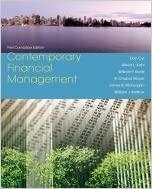Answered step by step
Verified Expert Solution
Question
1 Approved Answer
In Cwm Llif, each household has a wealth of 9 0 , 0 0 0 and a utility represented by U ( W ) =
In Cwm Llif, each household has a wealth of and a utility represented by Villagers live in three different areas, with different risks of having their homes flooded in any given year, as follows:
tableArea of village,# of households,Probability of floodingBrynDlNant
Suffering a flood reduces wealth to Assume that flooding risk is idiosyncratic each household floods independently of others in the village.
In the absence of flood insurance, what is the expected utility of the households in Bryn
In the absence of flood insurance, what is the expected utility of the households in Dl
In the absence of flood insurance, what is the expected utility of the households in Nant?
The national government sets up an insurance plan for flooding in Cwm Llif that is intended to be selffinancing over the long run, and provide full cover. Membership is optional, but since everyone is risk averse, the government assume that everybody will join. Premiums are set according to the chance that an average household gets flooded. Assume that equal proportions of the population live in each area. What is the premium?
If this premium is charged, which households will join the plan?
Calculate the expected profits or losses for the insurance plan.
Why has the scheme not broken even, as planned?
After the first year of operation, the government commissions a study to discover the probability that a member of the insurance plan gets flooded. It finds that the probability of flooding is For the second year of operation, they fix a new premium based on breaking even with this probability of flooding. What is the new premium?
Who joins the plan in the nd year?
Does the plan break even in year
Suppose now that the government gets smart and offers three plans, as follows:
Plan A: premium for full cover;
Plan B: premium for cover;
Plan C: premium for cover.
Show that this set of contracts satisfies the participation constraints all households choose to take out a plan incentivecompatibility constraints each household type takes out a different plan and is sustainable the government does not make a loss when offering them

Step by Step Solution
There are 3 Steps involved in it
Step: 1

Get Instant Access to Expert-Tailored Solutions
See step-by-step solutions with expert insights and AI powered tools for academic success
Step: 2

Step: 3

Ace Your Homework with AI
Get the answers you need in no time with our AI-driven, step-by-step assistance
Get Started


